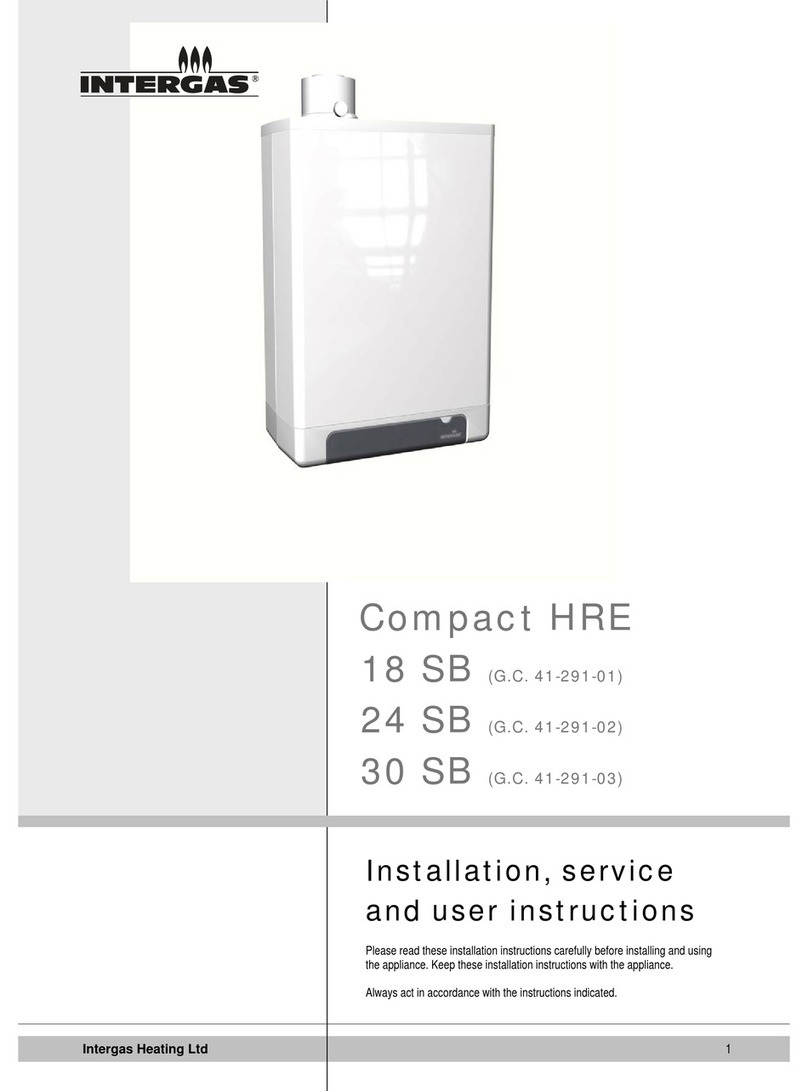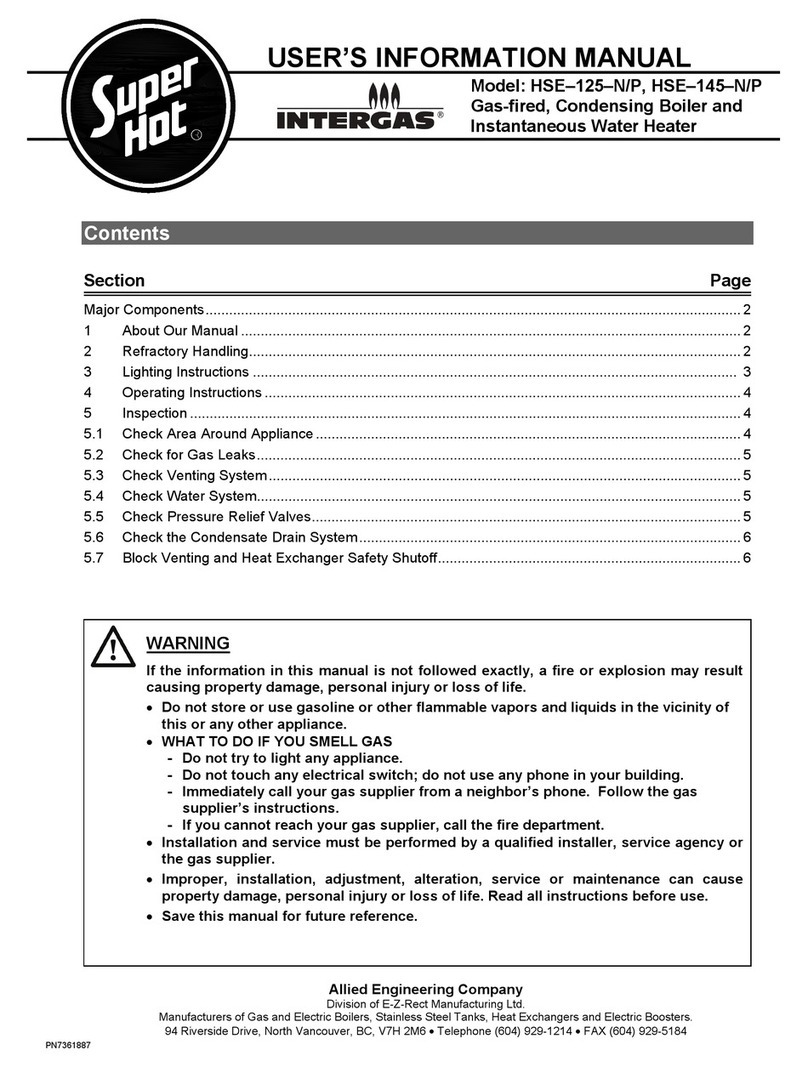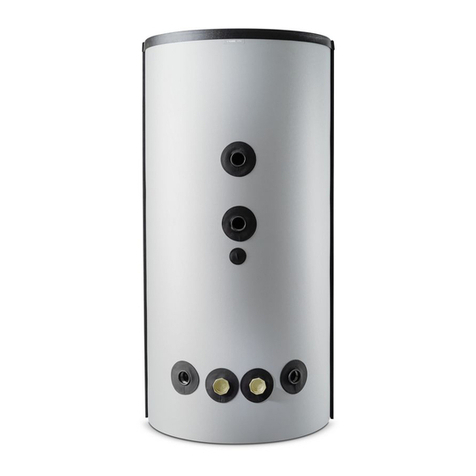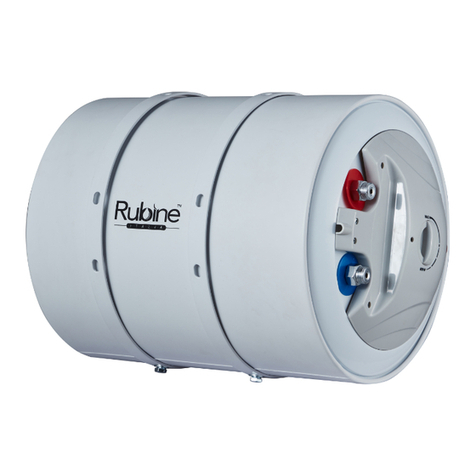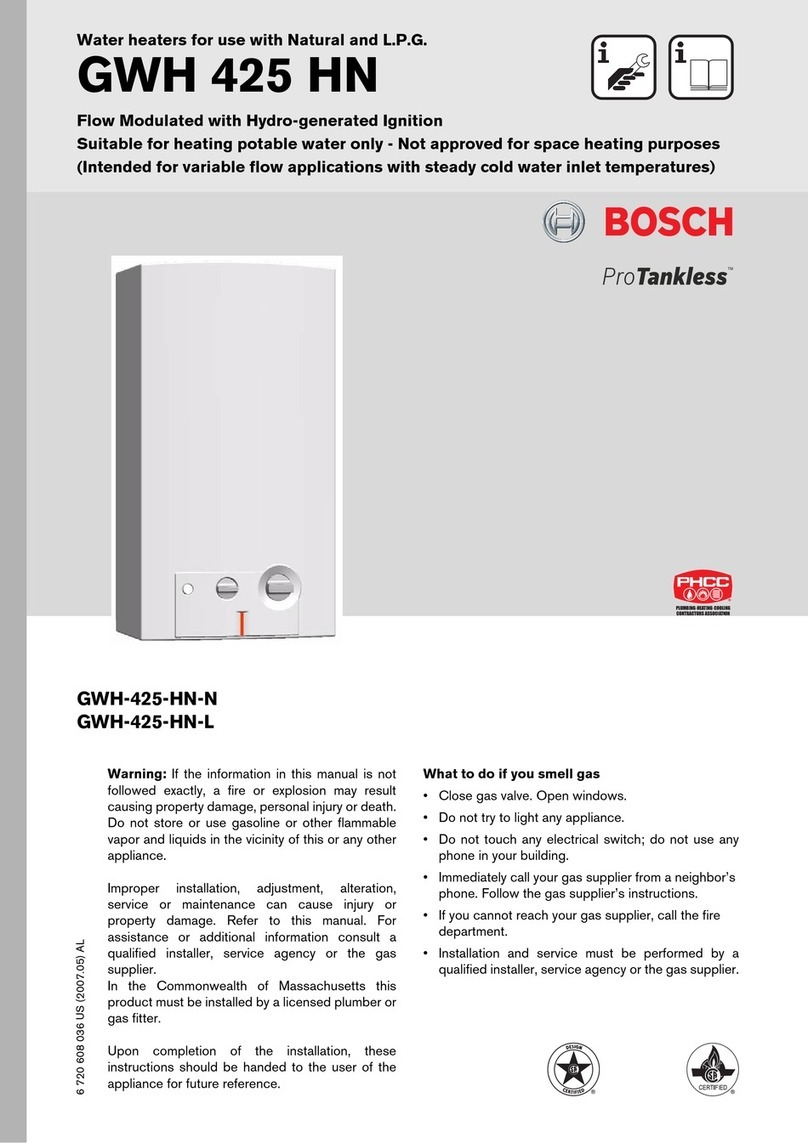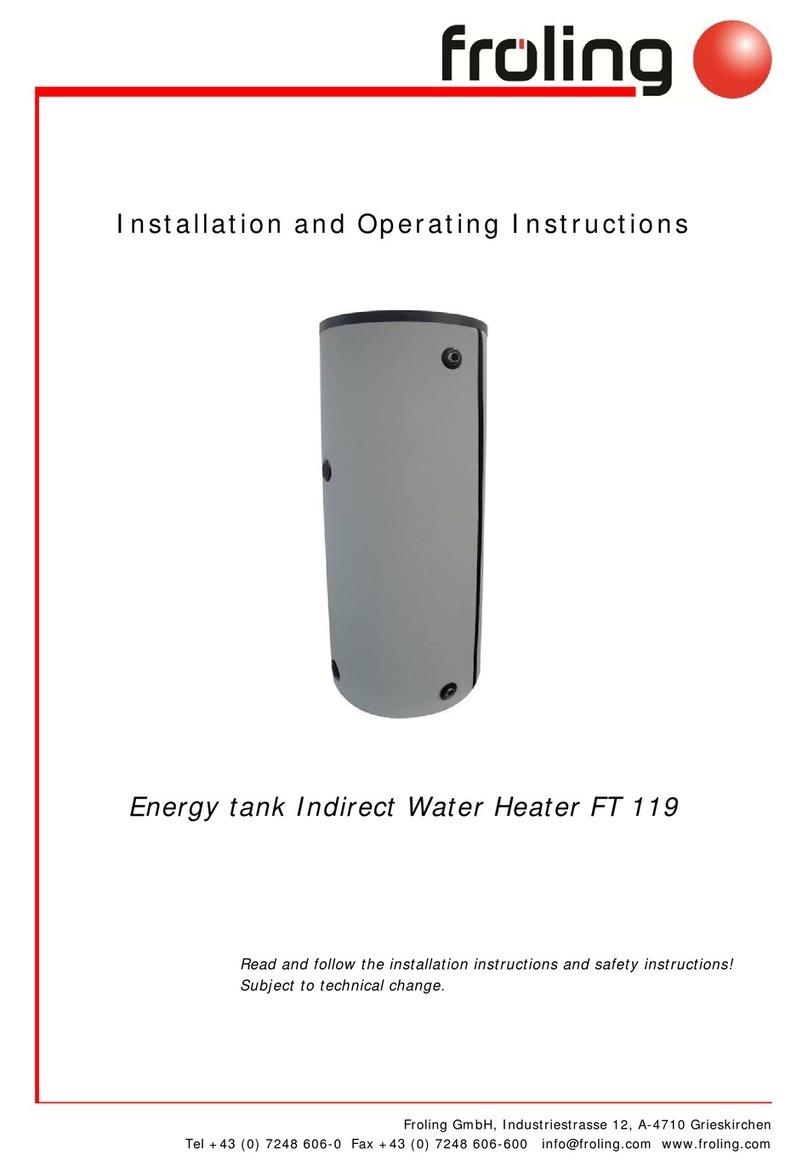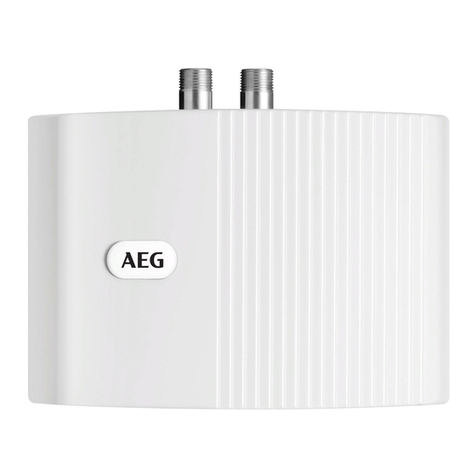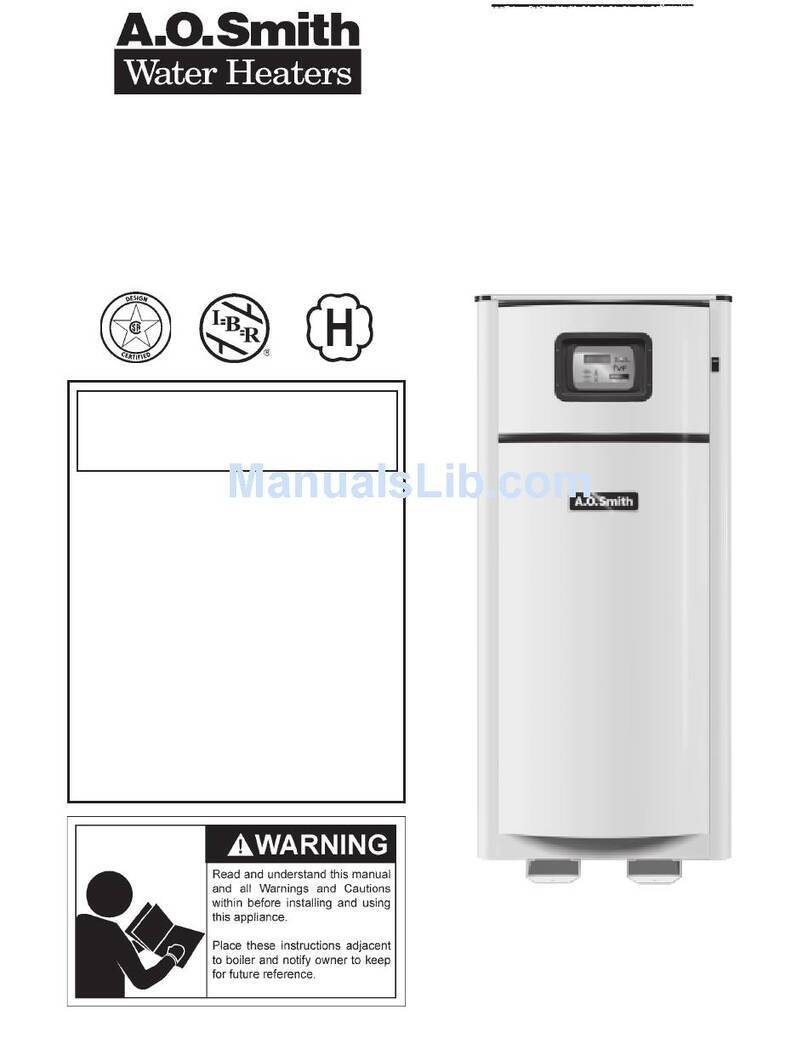Intergas Compact HRE 18 SB Manual

Intergas Heating Ltd 1
Compact HRE
18 SB
(G.C. 41-291-01)
24 SB
(G.C. 41-291-02)
30 SB
(G.C. 41-291-03)
40 SB
(G.C. 41-291-07 )
Installation service
and user instructions
Please read these installation instructions carefully before installing and using
the appliance. Keep these installation instructions with the appliance.
Always act in accordance with the instructions indicated.

Intergas Heating Ltd 2
Benchmark places responsibilities on both manufacturers and installers. The purpose is to ensure that customers are provided with the correct
equipment for their needs, that it is installed, commissioned and serviced in accordance with the manufacturer’s instructions by competent
persons and that it meets the requirements of the appropriate Building Regulations. The Benchmark Checklist can be used to demonstrate
compliance with Building Regulations and should be provided to the customer for future reference. lease read the Benchmark Checklist
carefully, page 50, and complete all sections, as required by law, relevant to the appliance and installation. The details within the Checklist will be
required in the event of any warranty work. On completion the Checklist must be left with the end user. The relevant sections of the Service
Record, page 51, must be completed on each subsequent Service visit.
Installers are required to carry out installation, commissioning and servicing work in accordance with the Benchmark Code of ractice which is
available from the Heating and Hotwater Industry Council who manage and promote the scheme. Visit www.centralheating.co.uk for more
information.
CONTENT
1
Preface 4
1.1
Regulation ........................................................................................................................................................................................ 4
1.2
Warnings .......................................................................................................................................................................................... 4
1.3
Manual handling .............................................................................................................................................................................. 4
1.4
Warnings on the bo ........................................................................................................................................................................ 4
1.5
Pictograms ....................................................................................................................................................................................... 4
1.6
Abbreviations and descriptions used ............................................................................................................................................... 5
1.7
This manual ..................................................................................................................................................................................... 5
1.8
Service and technical support ......................................................................................................................................................... 5
1.9
Product identification ....................................................................................................................................................................... 5
2
Safety regulations 6
2.1
General ............................................................................................................................................................................................ 6
2.2
The Installation ................................................................................................................................................................................ 6
2.3
Approvals ......................................................................................................................................................................................... 7
2.4
Technical data ................................................................................................................................................................................. 8
2.5
Components .................................................................................................................................................................................... 9
3
General boiler information 10
3.1
General .......................................................................................................................................................................................... 10
3.2
Boiler controller .............................................................................................................................................................................. 10
3.3
Parameter list................................................................................................................................................................................. 10
3.4
Heat transfer .................................................................................................................................................................................. 10
3.5
Central heating system .................................................................................................................................................................. 10
3.6
Room temperature control ............................................................................................................................................................. 10
3.7
Integrated clock ............................................................................................................................................................................. 10
4
O eration 11
4.1
General .......................................................................................................................................................................................... 11
4.2
Central heating mode .................................................................................................................................................................... 11
4.3
Operating modes ........................................................................................................................................................................... 11
4.4
Clock function ................................................................................................................................................................................ 12
4.5
PC Interface ................................................................................................................................................................................... 12
4.6
Test programs................................................................................................................................................................................ 13
4.7
Frost protection ............................................................................................................................................................................. 13
5
Installer im ortant oints 14
6
Accessories 15
7
Installation 16
7.1
Overall dimensions ........................................................................................................................................................................ 17
7.2
Installation location ........................................................................................................................................................................ 18
7.3
Assembly ....................................................................................................................................................................................... 19
7.4
Installing the appliance .................................................................................................................................................................. 20
8
Connection 21
8.1
Connecting CH installation ............................................................................................................................................................ 21
8.2
Connecting DHW storage cylinder ................................................................................................................................................ 21
8.3
Electrical connection ...................................................................................................................................................................... 22
8.4
Condensate disposal ..................................................................................................................................................................... 24
8.5
Flue System ................................................................................................................................................................................... 24

Intergas Heating Ltd 3
9
Commissioning the a liance 28
9.1
Filling and venting the appliance and the installation .................................................................................................................... 28
9.2
Commissioning the appliance ....................................................................................................................................................... 30
9.3
Setting and adjusting the clock functions ...................................................................................................................................... 31
9.4
Additional functions ....................................................................................................................................................................... 31
9.5
Shutting down ................................................................................................................................................................................ 32
10
Setting and adjustment 33
10.1
Directly via the operating panel ..................................................................................................................................................... 33
10.2
Setting via the service code .......................................................................................................................................................... 34
10.3
Parameters .................................................................................................................................................................................... 34
10.4
Setting ma imum CH power .......................................................................................................................................................... 35
10.5
Adjusting pump setting .................................................................................................................................................................. 35
10.6
Weather– compensation adjustment ............................................................................................................................................. 36
10.7
Checking gas-/air ratio .................................................................................................................................................................. 37
10.8
Setting gas/air adjustment procedure............................................................................................................................................ 38
10.9
Conversion to different gas type.................................................................................................................................................... 39
11
Faults 40
11.1
Fault codes .................................................................................................................................................................................... 40
11.2
Other faults ................................................................................................................................................................................... 40
12
Maintenance 43
12.1
Disassembly .................................................................................................................................................................................. 43
12.2
Cleaning ........................................................................................................................................................................................ 43
12.3
Assembly ....................................................................................................................................................................................... 44
12.4
Combustion ................................................................................................................................................................................... 44
13
Electrical diagram 45
13.1
NTC resistances ............................................................................................................................................................................ 46
13.2
Typical Y Plan connection ............................................................................................................................................................. 47
13.3
Typical S Plan connection ............................................................................................................................................................. 47
14
Short s ares List 48
15
Warranty Conditions 49
16
CE Declaration 49
17
Gas Boiler System Commissioning Checklist 50
18
Service Record 51
© 2013 Intergas Heating Ltd. All rights reserved.
The information provided applies to the standard version of the product. Intergas Heating Ltd cannot therefore be held liable for any loss or damage arising from product
specifications deviating from the standard version. The available information has been compiled with all possible care, but Intergas Heating Ltd cannot be held liable for
any errors in the information or for the consequences thereof.
Intergas Heating Ltd cannot be held liable for any loss or damage arising from work performed by third parties.
Subject to change.

Intergas Heating Ltd 4
1PREFACE
1.1 Regulation
The Intergas boiler meets the requirements of Statutory Instrument 'The Boiler (Efficiency)
Regulations' and is deemed to meet the requirements of:
•
Gas Appliance Directive 90/396/EEC
•
Boiler Efficiency Directive 92/42/EEC
•
Low Voltage Directive 2006/95/EC and
•
Electromagnetic Compatibility Directive 2004/108/EC
Intergas declares that the materials used in the manufacturing of this appliance are non-
hazardous and that no substances harmful to health are contained within the appliance.
1.2 Warnings
Intergas accepts no responsibility for the unsatisfactory performance of the appliance or flue
arising from the failure to comply with the installation and user instructions. Incorrect installation
could invalidate your guarantee and may lead to prosecution.
If the appliance is re-sold or installation transferred the appliance must be re-registered with
Intergas in order to maintain the warranty.
The boiler must be installed in accordance with these instructions and the regulations currently
in force. Read these instructions carefully before installing or using the appliance.
1.3 Manual handling
When moving the boiler always keep your back straight, bend your knees, don’t twist, move
your feet. Avoid bending forwards or sideways and keep the load as close to your body as
possible. Where possible transport the boiler using a suitable trolley, sack truck or get some
assistance. Grip the boiler firmly and before lifting establish where the weight is concentrated to
determine the centre of gravity, repositioning yourself if necessary.
1.4 Warnings on the box
This is a fragile iece of equi ment: Please rovide a dry
storage for the a liance.
This is a fragile iece of equi ment: Please be very careful
not to dro .
Store the a liance u right as indicated on the box.
No more than three boxes should be stacked on to of each
other.
1.5 Pictograms
The following pictograms are used in this manual:
CAUTION
Procedures which – if they are not erformed with the
necessary caution – can result in damage to the roduct, the
surrounding area or the environment, or in hysical injury.
WARNING HIGH VOLTAGE
Risk of electrical shock.
NOTE
Im ortant information regarding the correct usage or
installation of the a liance.

Intergas Heating Ltd 5
FROST PROTECTION
Procedures which must be followed to revent frost
damage.
1.6 Abbreviations and descri tions used
Descri tion Referred to as
High efficiency HE
Intergas Compact HRE SB wall mounted gas fired
boiler
Appliance
Appliance plus pipe work for central heating CH installation
Appliance plus pipe work for domestic hot water DHW installation
1.7 This manual
This manual will enable you to assemble, install and maintain the appliance safely. Follow the
instructions carefully. In case of doubt contact the manufacturer. Keep these installation
instructions with the appliance.
1.8 Service and technical su ort
For information about specific adjustments, installation, maintenance and repair work, please
contact:
Intergas Heating Ltd
Building 94, Bay 1 Vantage Point
The Pensnett Estate
Kingswinford
West Midlands
DY6 7FS
Tel: 01527 888000
Fa : 01384 279480
www.intergasheating.co.uk
1.9 Product identification
You will find the appliance data on the data plate on the underside of the appliance.
•Model
•G.C. registration number
•Heat input (net) [kW]
•Heat output CH [kW]
•Appliance category
•Gas type
•Gas supply pressure [mbar]
•NO class
•Appliance type
•Ma imum CH pressure [bar]
•Ma imum DHW pressure [bar] (not applicable for Compact HRE SB)
•Ma imum Flow temperature [°C] (not applicable for Compact HRE SB)
•Electrical supply
•Protection
•PIN
•Serial number
•Production year

Intergas Heating Ltd 6
2SAFETY REGULATIONS
The manufacturer Intergas Heating Ltd accepts no liability whatsoever for damage or injury caused
by failure to adhere (strictly) to the safety regulations and instructions, or carelessness during
installation of the Intergas Compact HRE SB High Efficiency wall mounted gas fired boiler and any
associated accessories.
2.1 General
It is law that all gas appliances are installed by a Gas Safe registered competent engineer and in
accordance with the following recommendations:
•
Current Gas Safety (Installation and Use) Regulations
•
All current building regulations
•
Building Standards (Scotland) Consolidated
•
This appliance must be installed in accordance with the Gas (Safety and Use) Regulations,
current Building Regulations, Building Standards (Scotland), I.S.813 Installation of Gas
Appliances (Ireland), IEE Wiring Regulations (BS 7671), Health and Safety Document No. 635
(Electricity at Work Regulations) and Local Water Authority Bye Laws
•
UK Water Regulations and Bye Laws
•
Health & Safety
2.2 The Installation
The installation must comply with the following British Standards codes of practice:
•
BS 5440: Flues and Ventilation for gas appliances of rated input not e ceeding 70kW (Part 1
Flues)
•
BS 5440: Flues and Ventilation for gas appliances of rated input not e ceeding 70kW (Part 2 Air
Supply)
•
BS 5546: 2000 Installation of gas hot water supplies for domestic purposes.
•
BS 5549: 1990 Forced circulation hot water systems
•
BS 6700: 1997 Design, Installation, testing and maintenance of services supplying hot water
•
BS 6798: 2000 Specification for installation of gas fired hot water boilers of rated input not
e ceeding 70kW
•
BS 6891: 1998 Installation of low pressure gas pipe-work installations up to 35mm (RI)
•
BS 7593: 1992 Code of practice for treatment of water in heating systems
•
BS 7671: 2001 Requirements for electrical installations, IEE Wiring regulations
Reference should also be made to:
•
Guide to condensing boiler installation assessment procedures for dwellings
•
The institute of Gas Engineers document IGE/UP/7 for timber frame dwellings

Intergas Heating Ltd 7
2.3 A rovals
Natural Gas
Intergas Compact HRE SB Pre-mi Condensing System Boiler
British Gas Service Listing:
Compact HRE 40 SB G.C.N. 41-291-07
Compact HRE 30 SB G.C.N. 41-291-03
Compact HRE 24 SB G.C.N. 41-291-02
Compact HRE 18 SB G.C.N. 41-291-01
Notified /Body
The Intergas Compact HRE SB range of central heating boilers are manufactured from high
quality materials and designed for reliability and optimum performance.
Intergas is committed to the continual development of their appliances and reserves the right
to make changes without notification to ensure their customers benefit from the latest
advances in combustion technology and energy conservation.
Gastec 0063PT3576 Directive 90/396/EEC
Directive 92/42/EEC

Intergas Heating Ltd 8
2.4 Technical data
Appliance category C13; C33; C43; C53; C83
Gas supply pressure 20 mbar -G20 ; 37 mbar – G31
Gas Category II2H3P
Technical data Com act HRE 18 SB 24 SB 30 SB 40 SB
Gas Council number G.C. 41-291-01 G.C. 41-291-02 G.C. 41-291-03 G.C. 41-291-07
CH
Nom. Input rating (lower value)* kW 5.6 – 18.7 7.1 – 23.7 7.6 – 27.0 7.8 – 42.5
Rated power* kW 6.1 – 18.2 7.7 – 23.1 8.2 – 26.6 8.4 – 40.9
Ma . CH water pressure bar 2.5 2.5 2.5 2.5
Ma . CH water temperature °C 90 90 90 90
Other data
Gas consumption (G20) m
3
/h 0.58 – 2.29 0.75 – 2.91 0.79 – 3.39 0.80 – 4.41
Gas consumption (G31) m
3
/h 0.22 – 0.87 0.28 – 1.11 0.30 – 1.29 0.31 –1.68
Appliance pressure loss (CH) mWk See § 10.5 See § 10.5 See § 10.5 See § 10.5
NO class natural gas 5 5 5 5
NO class LPG 5 4 5 5
Electrical data
Mains power V 230 230 230 230
Safety class IP IP44 IP44 IP44 IP44
Power consumption : full load W 130 130 130 190
Power consumption: partial load W 40 40 40 40
Power consumption: standby W 2 2 2 2
Boiler dimensions and weight
Height mm 590 650 710 710
Width mm 450 450 450 450
Depth mm 240 240 240 240
Weight kg 30 33 36 36
We have a policy for continual improvement and development, therefore we reserve the right to change specifications without prior notice.

Intergas Heating Ltd
9
2.5 Com onents
A. CH pump K. Sight glass
B. Gas valve L. Air supply cap
C. Boiler controller M. Flue pipe adapter (only to be used in combination with the
accompanying elbow in flue sets).
D. Sensor S1 N. Connection block / terminal strip X4
E. Sensor S2 O. Condensate drain pan
F. Fan P. N.a.
G. N.a. Q. Condensate trap
H. CH pressure sensor R. Heat e changer
I. Mains lead 203 V AC without plug (stripped) S. Operating panel and read-out
J. Manual air bleed T. Ionisation / ignition electrode
U. Position of data plate

Intergas Heating Ltd 10
3GENERAL BOILER INFORMATION
3.1 General
The Intergas Compact HRE SB wall mounted, gas fired boiler is a closed appliance.
The appliance is intended to transfer heat to the water circuit in a CH system and when
an indirectly heated domestic hot water (DHW) storage cylinder is installed, apply heat
to the DHW installation.
The air supply and combustion gas flue connection is as standard prepared for a
concentric 60/100 horizontal flue system. The appliance can be connected to a wall
mounting jig and e pansion vessel. The appliance can also be connected without the
wall mounting jig using the robo kit.
The Intergas Compact HRE SB wall mounted gas fired boiler carries the CE rating and
IP44 electrical protection.
The appliance is supplied as standard for natural gas (G20). For usage of propane gas
(G31) the boiler can be modifed by changing the gas injector. A gas conversion kit can
be ordered at Intergas Heating Ltd.
NOTE
Modification of the boiler can only be done by a qualified
competent person.
3.2 Boiler controller
An electronic control unit, consisting of a boiler controller and separate ignition module
which is placed on the gas valve, provides direct burner ignition and flame supervision
along with continuous modulation of the burner’s gas supply.
3.3 Parameter list
All boiler adjustments are accessible through the parameter list in the software.
3.4 Heat transfer
Heat transfer to the boiler’s heating circuit is obtained via a primary, gas to water heat
e changer within a hermetically sealed combustion chamber. A modulated speed fan
blows the gas/air mi ture into the combustion chamber and e pels the products of
combustion to outside air via an associated flue system.
3.5 Central heating system/automatic by- ass
An integral pump located in the boilers hydraulic circuit circulates water through the
heat e changer to the central heating circuit. In the event of reduced or interrupted
water circulation in the central heating circuit, an automatic system by-pass should be
fitted as far away from the boiler as possible.
Note
It is no longer permissible to utilize a non-thermostatic controlled radiator as a by-pass.
3.6 Room tem erature control
Room temperature can be controlled by the use of an e ternal room thermostat and
thermostatic radiator valves.
Note
Connection of the room thermostat is dependant on the operating voltage of the
thermostat.
3.7 Integrated clock
The boiler incorporates an integrated clock, which allows the setting of central heating
periods (See the User Instructions, ‘Operation and display read-out’ for details) and the
boiler’s control panel incorporates an LED display, which indicates the state of
operation and fault defect codes.
Note
For S and Y plans set integral clock to C-ON and fit an external timer/programmer.

Intergas Heating Ltd
11
4OPERATION
4.1 General
The Intergas Compact HRE SB wall mounted, gas fired system boiler is a modulating high
efficiency boiler. This means that the power is adjusted in line with the desired heat
requirement.
The appliance is equipped with an electronic boiler controller which, each time heat is
requested from the heating supply, starts the fan, opens the gas valve, ignites the burner
and continuously monitors and controls the flame, depending on the requested output.
4.2 Central heating mode
When a heating demand is requested (power is on, the timer and thermostat are calling for
heat) the integral pump is energised and the boiler will fire automatically. The hot water is
now circulated around the central heating system. When the end of the central heating
demand is reached (the thermostat reaches temperature or the time clock reaches the end
of its set period) the burner will shut down while the pump remains functioning during a
preset period of time to dissipate any e cess heat from within the boiler’s heat-e changer.
After that the boiler will revert to stand-by, waiting to respond to the ne t heating demand.
4.3 O erating modes
A code on the service display of the operating panel indicates the appliance’s operating
mode.
- Off
The appliance is out of operation but is supplied with electrical power. No response occurs
to calls for DHW or CH. The appliance frost protection is active. This means that the pump
operates and the e changer is heated up if the temperature of the water present in it falls
too far.
If the frost protection is actuated, code 7 is displayed (heating the e changer).
In this operating mode the pressure in the CH installation (in Bar) can also be read on the
temperature display.
Waiting mode
The LED at the button is lit and possibly one of the LEDs for the DHW comfort function.
The appliance is ready to respond to a request for CH of DHW.
0 Pump overrun of CH
After the end of CH operation the pump continues to run. The running time is factory set at
the value in accordance with § 10.3. This setting can be changed.
In addition, the pump runs automatically for 10 seconds once every 24 hours in order to
prevent seizing. This automatic switching on of the pump occurs at the time of the last call
for heat. To change the time, the room thermostat setting should be increased briefly at the
desired time.
1 Boiler shutdown when required temperature reached
The boiler controller can temporarily shut down the request for heat. The burner is then
stopped. Shutdown occurs because the requested temperature has been reached. When
the temperature has fallen sufficiently and the anti cycle time has passed the shutdown is
cancelled.
2 Self-test
The connected sensors are checked regularly by the boiler controller. During the check the
boiler controller does not perform any other tasks.
3 Ventilation
When the appliance is started the fan is first brought to starting speed. When the starting
speed has been reached the burner is lit. Code 3 is also visible when post-ventilation is
taking place after the burner has stopped.
4 Ignition
When the fan has reached the starting speed, the burner is ignited by means of electrical
sparks. During ignition the code 4 is visible. If the burner does not ignite, a new ignition
attempt occurs after appro imately 15 seconds. If after 4 ignition attempts the burner is not
yet burning, the boiler controller goes into fault mode (See § 11.1 ).
5 CH operation

Intergas Heating Ltd 12
An on/off thermostat, an OpenTherm thermostat, an e ternal sensor or a combination of
the latter can be connected to the boiler controller.
When a request for heat is received from a thermostat, the fan is started (code 3 ),
followed by ignition (code 4 ) and CH operating mode (code 5 ).
During CH operation the fan speed and hence the appliance power are controlled by
the boiler controller so that the CH water temperature reaches the desired CH supply
temperature.
If an on/off thermostat is connected, this is the CH supply temperature set on the
display. In the case of an OpenTherm thermostat the desired CH supply temperature is
determined by the thermostat. In the case of an e ternal sensor the desired CH suppply
temperature is determined by the heating line programmed in the boiler controller. For
the latter two, however, the ma imum is the temperature set on the display.
During CH operation the requested CH supply temperature is indicated on the operating
panel.
The CH supply temperature can be set between 30°C and 90°C.
4.4 Clock function (heat only)
The boiler is equipped with a digital clock and offers the possibility to program 4 points in time
to switch from CH off or CH on.
During the “clock active” periods the boiler will respond on CH demands from the room
thermostat. During the “clock inactive” periods the boiler will not respond on CH demands.
N.B. The clock function is only applicable when using the boilers as “heat only”. When using the
boiler in combination with an e ternal DHW tank, for e ample in an S or Y plan wired installation
the clock must be set to C-on.
Additionally the following special modes can be chosen:
1. t-on (temporary on).
The boiler will respond to every CH demand from the room thermostat until the ne t switch
moment.
2. c-on (continuous on).
The boiler will respond to every CH demand from the room thermostat without any time limit.
3. OFF.
The boiler will not respond to any CH demand from the room thermostat.
NOTE
For setting and adjusting the clock see § 9.3 Setting and adjusting the clock
functions.
4.5 PC Interface
The boiler controller is equipped with an interface for a PC, which can be connected by
means of a special cable and associated Intergas Diagnostic Software (IDS). This
facility allows the behaviour of the boiler controller, the appliance and the heating
installation to be monitored over a longer period.

Intergas Heating Ltd
13
4.6 Test rograms
The boiler controller has a facility for placing the appliance in test mode. Activation of a
test program will result in the appliance starting operation at a fi ed fan speed, without
the control functions being actuated. The safety functions do remain active. The test
program is ended by pressing the and simultaneously or will end automaticaly
after 10 minutes.
Test rograms
Program descri tion Button
combinations
Dis lay reading
Burner on at minimum power and “L”
Burner on with ma imum CH power
setting (See § 10.3, parameter 3) and (1 ) “h”
Burner on with ma imum DHW power
(See § 10.3, parameter 4) and (2 ) "H"
Switch off test program and Actual situation
4.7 Frost rotection
FROST PROTECTION
To revent freezing the a liance is equi ed with an internal frost
rotection. If the heat exchanger tem erature falls too low, the burner
switches on and the um runs until the heat exchanger tem erature
is sufficient. When the a liance frost rotection is activated the
symbol code 7
77
7
is dis layed ( re heating the heat exchanger).
If the installation (or a art of it) is in danger of freezing, an (external)
frost thermostat must be fitted to the return line at the coldest location.
This must be connected in accordance with the wiring diagram
(See § 8.3).
NOTE
If the a liance is out of o eration ( -
on the service dis lay) the a liance’s
internal frost rotection is still active. However, there will be no res onse to a
heating demand from an (external) frost thermostat.

Intergas Heating Ltd 14
5INSTALLER IMPORTANT POINTS
Please read all instructions before fitting this a liance
•
The installer shall instruct the user on the operation of the boiler, safety devices
contained within the boiler and on the location of the filling loop and how to re-pressurise
the system if the water pressure falls.
•
The installer should then hand over the instructions indicating the included Benchmark
Commissioning Checklist that has been completed.
•
It is required under Gas Safe Regulations for the installation to be notified to Building
Control (Gas Safe Notifcation).
•
Before proceeding to commission the boiler check the gas inlet pressure is 20mbar (NG)
or 37mbar for Propane.
•
Combustion analysis with a correctly calibrated and certificated analyser is essential for
safe commissioning of the boiler.
•
A pressure reducing valve set to 3.5 bar must be fitted if supply mains pressure is above
4 bar.
•
A suitable scale reducer must be fitted if water hardness is above 200 ppm.
•
The user should be instructed to keep the instructions in a safe place for servicing and
future reference.
•
It is important to keep the boiler clear of dust during the installation. In particular, do not
allow debris to enter the flue connection at the top.
•
Before fitting the boiler ensure that the pipe work that you are installing is connected to
the appropriate connections on the boiler.
It is important to thoroughly flush the water circuits, after isolating the boiler, in order to
remove any flu es and debris from them. This should be done particularly where boilers
are being fitted to e isting radiator circuits (please refer to current Standard Codes of
Practice).
•
BS 7593:2006 for the details to clean DHW and Central heating system.
•
This boiler has been factory set but adjustment may be required to the heating input in
order to match the individual heating demand. This can be done by changing parameter
3 (= ma . power CH) or parameter 4 (= ma . power domestic water).
•
Please do not use the pressure relief valve as a means of flushing the system.
•
Remember that after hot water draw of a possible delay may occur before the heating
system will fire up.
•
All flu es, residues and cleaner must be flushed from pipe-work and radiators prior to
commissioning.
•
E ternal e pansion vessels are best connected water side downwards to allow correct
draining/cleaning of system and to prolong the life of the vessel diaphragm.
•
Note: an anti-cycle delay time can be set up to a ma imum of 15 minutes by adjusting
parameter P as described in § 10.3.
•
If you e perience any problems please refer to the installation and commissioning
guidelines within the boiler instruction manual. If necessary, please contact Intergas
Heating Ltd (See § 1.8).
Remember it is a requirement to complete the Benchmark code of practice logbook before
leaving the installation. You are also required to register the boiler through the Gas Safe
registration scheme.

Intergas Heating Ltd
15
6ACCESSORIES
Descri tion Article number
Pi e cover set (incl. mounting material) 093217
Wall mounting jig + ex . vessel 8 litres HRE SB 30 & SB 40
093207
Wall mounting jig + ex . vessel 8 litres HRE SB 24
093197
Wall mounting jig + ex . vessel 8 litres HRE SB 18
093187
Outside sensor 203207
DHW storage cylinder sensor 065117
Diverter valve 230 V 092647
Concentric connection (boiler ada ter)
Ø6
0x100
•
Concentric flue adapter
•
Sealing cap
Neccesary when connecting to a higher positioned wall terminal
090547
Sam ling ca 847000
Bend 45° 084661
Bend 90° 084660
Deflector kit 081295
Weather slate (stee roof) 087910
Weather slate (flat roof) 087372
Extension L=100 incl. wall bracket 082975
Horizontal straight wall terminal extended
Only to be used in combination with the base adapter on the boiler
082980
Horizontal telesco ic wall terminal
Only to be used in combination with the base adapter on the boiler
081297

Intergas Heating Ltd 16
Descri tion Article number
Horizontal telesco ic offset wall terminal
Only to be used in combination with the base adapter on the boiler
081298
Vertical roof terminal
(incl. boiler adapter 60/100)
082973
Plume management kit
081294
Elbow 90° ((for Plume management kit)
081284
Elbow 60° (for Plume management kit)
081285
Extension L=100 incl. wall bracket (for Plume management kit)
081286
Robo kit 12 litres
090000
Robo kit 8 litres
090100

Intergas Heating Ltd
17
7INSTALLATION
7.1 Overall dimensions
A liance inclusive wall mounting jig:
A liance + wall mounting jig + bracket
A =
Supply CH
Ø22
B =
Return CH
Ø22
C =
Gas
½”
F =
Condensate drain
Ø25 (fle ible)
G =
Drain PRV
Ø15
H=
840
(*)
Compact HRE SB 30
& SB 40
H =
780
Compact HRE SB 24
H =
720
Compact HRE SB 18
Z =
Flue pipe / air
supply
Ø60/100 (concentric)
(*) Note: The condensate trap of the SB 40 protrudes below
pipe cover and wall mounting frame.

Intergas Heating Ltd 18
7.2 Installation location
•
If the boiler is to be installed in any room or compartment, it does not require any
purpose made ventilation for combustion air. If sited in a room containing a bath or
shower then particular reference is drawn to the current I.E.E. Wiring Regulations,
local Building Regulations or any other local regulations currently in service.
•
The boiler is not suitable for e ternal installation unless protected by a purpose
made building such as a boiler house.
•
The following clearances are recommended for installation purposes: 200mm
above, 300mm below and 10mm at each side. 500mm is required at the front but
this may be realized by opening a cupboard door.
•
Flammable fluids and materials must be stored at least 1m away from the boiler
•
The wall on which the boiler is mounted must be sufficiently strong to support the
weight of the boiler.
7.2.1 Installing in a kitchen cu board
The appliance can be installed between two kitchen cabinets or in a cabinet. Ensure
sufficient ventilation at top and bottom. When installed in a cabinet, ventilation
openings of at least 50 cm
2
must be created at the top and bottom of the appliance to
ensure free flow of air.
7.2.2 Removing cover late and front anel
For various work on the appliance the cover plate and front panel should be removed
from the appliance. Proceed as follows:
•
If cover plate (A), is used, remove to the front.
•
Unscrew the two screws (1) behind the appliance display window.
•
Pull the bottom of the front panel (2) forwards.
A

Intergas Heating Ltd
19
7.3 Assembly
The boiler can be mounted either on the fi ing strip which is supplied in the bo or to a wall
mounting jig with an e pansion vessel.
The wall mounting jig includes an e pansion vessel and shut off valves.
If the fi ing strip is used an e ternal ROBO kit must be fitted as well.
7.3.1 Using the wall mounting jig
•
Using the fastening materials supplied, secure the jig vertically to the wall.
Make sure the wall is suitable for placing the boiler.
•
Secure the bracket with the shut-off valves in the jig by inserting it with the flanged
side upwards through the openings (sleeves) in the jig.
N.B. The appliance is ider than the jig.
•
Install the CH heating system to the valves (DHW connections remain unused).
NOTE
All valves, with the exce tion of the return valve must be in a
vertical osition for o en. The return valve must be in
horizontal osition for o en.
CAUTION
Make sure that the boiler connections of the shut off valves
remain in the correct osition (= straight u wards).Exce t
the return valve on the wall mounting jig which is horizontal
when o en. Do not over tighten connections. Do not turn
tightened valves on i es as this weakens joints within the
boiler.
7.3.2 Using the fixing stri + ROBO kit
•
Position the fi ing strip to the wall and drill the holes.
•
Using appropriate fi ing materials, secure the strip horizontally to the wall.
Make sure the wall is suitable for placing the boiler.
•
Hang the boiler on the fi ing strip and connect the ROBO kit to the boiler and
installation.
H= 840 Compact HRE SB 30 & SB 40
H= 780 Compact HRE SB 24
H= 720 Compact HRE SB 18
+

Intergas Heating Ltd 20
7.4 Installing the a liance
1. Unpack the appliance.
1. Check the contents of the packaging. It consists of:
•Appliance (A)
•Fi ing strip (B)
•Condensate trap (C)
•Installation instructions and operating instructions
•Warranty card
•Templates for either wall or jig mounting
2. Check the appliance for possible damage: report damage immediately to the supplier.
3. Decide either to use the fi ing strip (supplied) or wall mounting jig.
4. The templates show the positions for the horizontal flue. Drill the e it holes, being sure to
prevent dust or debris from entering the boiler or pipe-work.
5. If the fi ing strip is secured to the wall then slide the boiler down until latched.
6. If the jig is fi ed securely to the wall then it is possible to fit the pipe connections prior to
hanging the boiler. Pipe connections are (from right to left) as follows for both methods: PRV
15 mm – CH flow 22mm – Gas 22 mm – Return 22 mm. IMPORTANT. The gas su ly
should be minimum 22mm u to gas isolation valve on boiler. It is the installers
responsibility to ensure sufficient gas supply.
7. Check whether the compression rings are sitting squarely in the mounting bracket couplings.
8. Fit the appliance, sliding it downwards on the jig. Ensure at the same time that the pipes
slide into the compression fittings.
9. Tighten the compression fittings on the mounting bracket. Do not turn tightened valves on
pipes as this weakens joints within the boiler.
10. Fit the fle ible tube to the condensate trap outlet.
11. Fill the condensate trap with water and slide it as far as possible upwards on to the
condensate drain connector below the appliance.
CAUTION
The Com act HRE 40 SB is only to be installed with the condensate
tra ( length =235 mm) included in the boiler ackage.
When re lacing the condensate tra make sure the correct version is
ordered (art.nr. 844787). Using an incorrect condensate tra can lead
to otentially unsafe situations.
12. Connect the fle ible tube from the condensate trap to the drain via an open connection. The
condensate discharge system must be made of plastic, no other materials may be used.
The discharge duct must have a minimum gradient of 5 – 20 mm/m. Condensate discharge
via the gutter is not allowed given the risk of frost and the possible damage to materials.
13. Fit the flue in accordance with the instructions mentioned in § 8.4.4. Allow 15mm of white
tube e ternally to ensure the flue sealing ring is fitted correctly. No white part of the flue
should be visible e ternally once the black sealing ring is fitted correctly.
CAUTION
Always fill the condensate tra with water and lace
it on the boiler before owering u the boiler.
Not lacing or filling u the condensate tra may
cause flue gases to come into the installation room
and can lead to dangerous situations!
In order to lace the condensate tra the front cover
must be ulled forward or removed entirely.
NOTE
It is recommended that any external condensate pipe is insulated
and increased to 32mm diameter in order to prevent the
condensate from freezing.
7.4.1 Fitting the cover late (o tional)
Hang the flanged upper edge of the cover plate on the washers under the base of the appliance
and slide the cover plate as far as possible towards the rear.
Other manuals for Compact HRE 18 SB
2
This manual suits for next models
7
Table of contents
Other Intergas Water Heater manuals
Popular Water Heater manuals by other brands
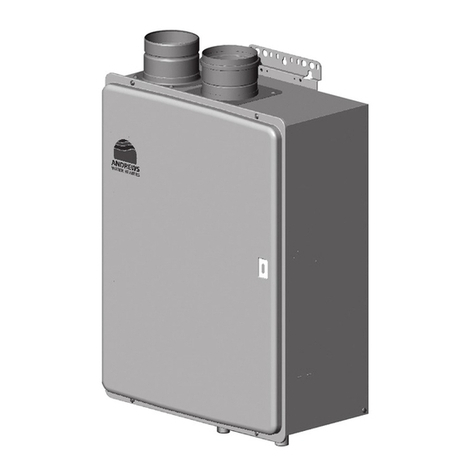
andrews
andrews Fastflo WHC56 Service manual
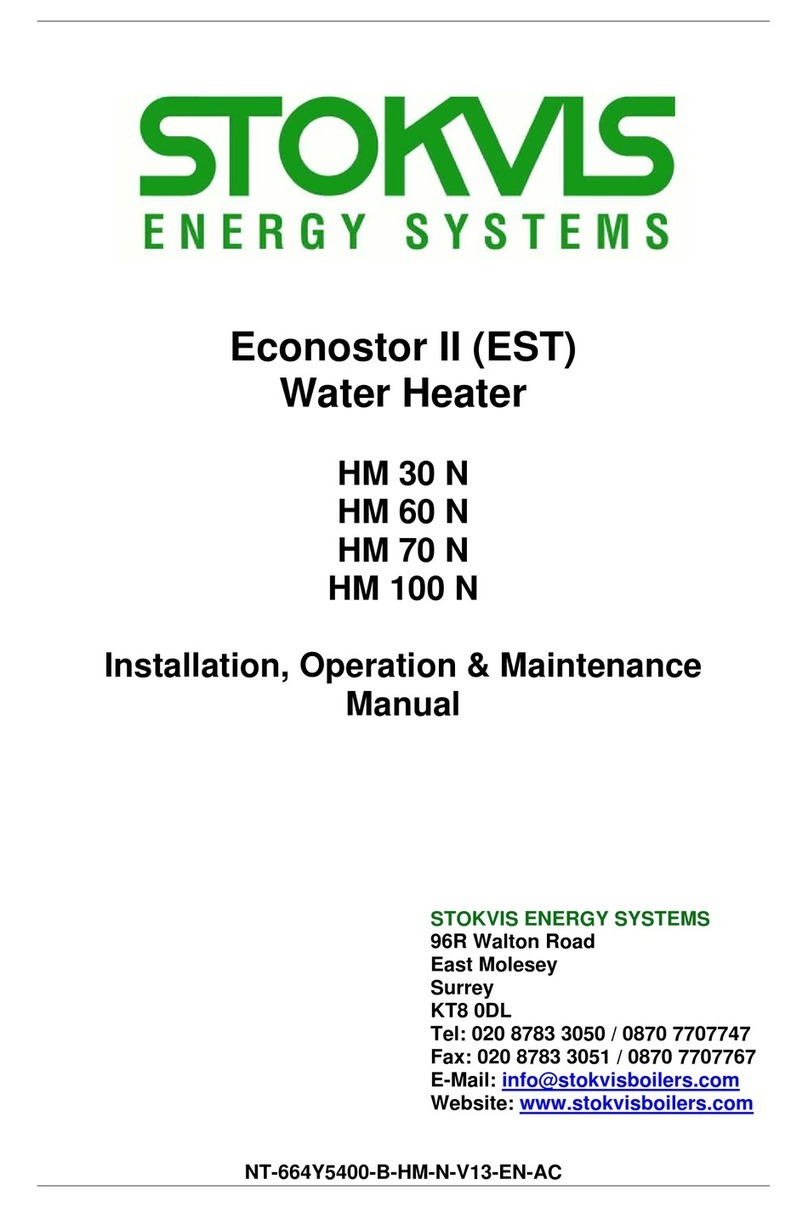
STOKVIS ENERGY SYSTEMS
STOKVIS ENERGY SYSTEMS Econostor II Installation, operation & maintenance manual
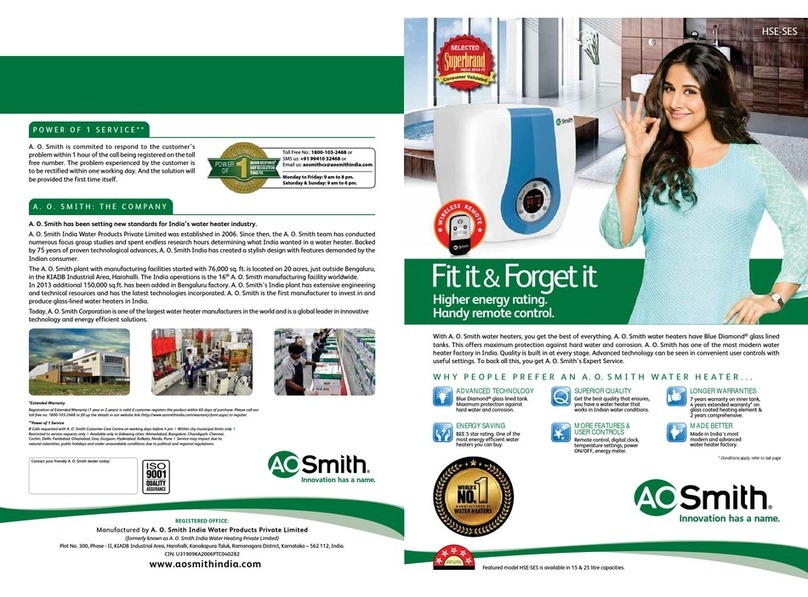
A.O. Smith
A.O. Smith HSE-SES-025 user guide
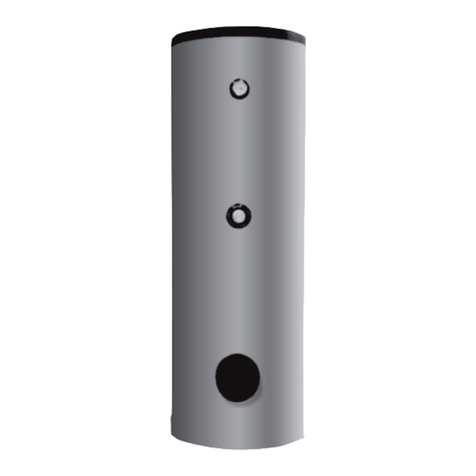
Gorenje Tiki
Gorenje Tiki KGV 400 Instructions for use
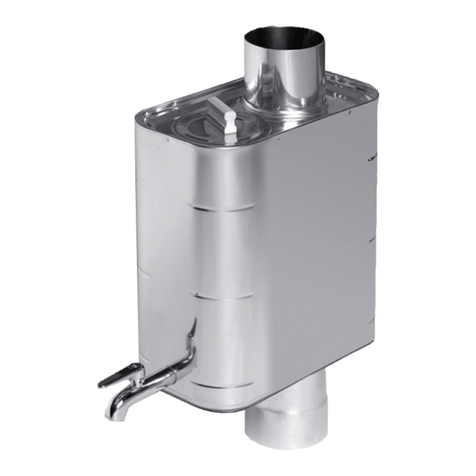
Harvia
Harvia VL22l manual

THERMEx
THERMEx Nova 50 Series user manual
